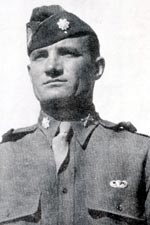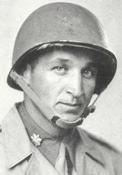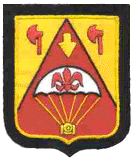|
|
. 466th PFAB . Parachute Field Artillery
Battalion |
|
On the 1st of August, 1943, the 466th Parachute Field Artillery Battalion was activated at Camp Mackall, North Carolina. Its members were picked from those who were graduating from the Parachte School at Fort Benning, Georgia and from the replacement pools at Camp Mackall. Many of the men were old soldier and parachute training was something new and exciting.
Originally, the Battalion was under the command of Lieutenant Colonel Raymond L Cato.
 <-
Lieutenant
Colonel Raymond L. Cato
<-
Lieutenant
Colonel Raymond L. Cato
For the first training, the men were not as much material. During the first exercices schedule came from the Airborne Command, they simulated gun drill with logs and sticks as howitzers. But soon our 75mm packs howitzers arrived and we spent many hours "getting acquainted" with them.
In the months that followed, the battalion passed all the tests given by the Battalion and by the Airborne Command where the men combined efficiency, speed and durability. The scores on the Fort Bragg and North Ranges made records.
No men will forget the 16 mile road marches with full field equipment, pulling the howitzers by hand.
At Camp Mackall, the Battalion made 4 parachute jumps, two of them at night.
The 4th of March, the 466th PFAB arrived at the Tennessee Maneuver area - in time for the raining season. The men realized how very much like actual combat a maneuver period can be.
The 10th of March, the 466th PFAB was released by the Airborne Command and assigned to the 17th Airborne Division. By the 25th of March, the Battalion were at Camp Forrest, Tennessee for more training for learned to work with other units as a Combat Team. Again, there were 3 jumps - one at night.
At this time, Lt. Col. Cato (transfered to 460th PFAB) was replaced by Lt. Col. Kenneth L Booth.
 <-
Lieutenant
Colonel Kenneth L Booth
<-
Lieutenant
Colonel Kenneth L Booth
The 16th of August, after a train trip, the unit arrived at the Camp Miles Standish, staging area in Massachusetts. 4 days later, the men embarked from Boston Harbor aboard the SS Wakefield for the European Theater of Operation.
The ship dockedat Liverpool, England the 28th of Augustus 1944. Then, the Battalion was transported by train to his new home, Camp Chiseldon in just South of Swindon in Wiltshire. Again, men mademore parachute training jump. The 3rd of October, a practice jump wounded 19 men because of the wind.
![]() Belgium
– Decembre 1944 – Battle of the Bulge
Belgium
– Decembre 1944 – Battle of the Bulge
On December 16, 1944, the
Germans launched an offensive through theBelgium Ardennes surprising
the Allies.
The VIII Corps under
the command of General Troy
Middleton had desperately need
reinforcement.
The 82nd and 101st
Airborne recently withdrawn from Holland were
at rest in France.
The 17th Airborne was
still in England in
Camp Wiltshire andSurrey for
the training. The headquarters
of the XVIII Airborne Corps was
traveling between Epernay, France and Ogbourne
St George, England.
The early success of the German offensive persuaded
the General Eisenhower,
Supreme Commander to linked the XVIII
Airborne Corps to 12th
Army Group. The 82nd and 101st
Airborne were sent by truck to Belgium in
the Ardennes sector was the 1st U.S.
Army.
The 17th
Airborne remained in England,
it was only later that she left the country to fight with the 3rd
U.S. Army.
On December 22, the 466th PFAB arrived at Greenham Commons airfield and marshalling area. At this point, the men were alerted by a counter-intelligence report that a possible coordinated prison break and enemy parachutist drop might take place; it did not.
On 29 December 1944, at 12:30 departed in C-47 airplanes for France. Upon landing, its proceeded to Mourmelon-le-Grand. It arrived there at 17:00 and rode by truck that night and the following day to Verdun, France where it went into position. This began officially its participation in the Ardenne Campaign.
The 3 January 1945, the Battalion arrived at a position in Sibret, Belgium. Here, the Battalion met the first enemy resistance and on the 4th January heavy ennemy fire came on its flanks; it quieted at nightfall.
The 7 January, the 466th PFAB moved to Chenogne, Belgium and here suffered two casualties in the battery position from ennemy artillery.
Here is the list the towns where the Battalions fought and the dates of its arrival at each:
14 January
arrived at Frenet, Belgium
17 January arrived at Malompre, Belgium
20 January arrived at Houffalize, Belgium
21 January arrived at Cetturu, Belgium
22 January arrived
at Steinbach, Belgium
24 January arrived at Linere, Belgium
25 January arrived at Wattermal, Belgium
Le 26 January ended the Ardennes Campaign, began the Rheinland Campaign.
27 January arrived
at Diefiet, Belgium
28 January arrived at Munshausen, Luxembourg
29 January arrived at Marnach, Luxembourg
At Marnach, the Battalion were stalemated. The 75mm howitzers had no effect on the heavily fortified Siegfried Line.
On the February 12, ended the Rheinland Campaign and the men left the front for a base camp in Sondron, France near Chalons sur Marne for a well earned rest. The 19th of March, the Battalion were alerted for another marshalling area near Mourmelon-le-grand and were briefed on the real thing - their first combat parachute jump. The jump across the Rhine river.
![]() Germany
– March 1945 – Operation Varsity
Germany
– March 1945 – Operation Varsity
The Battalion loaded into 42 C-47 airplanes at 08:00 on the 24th March 1945. The mission was direct support of the 513th Parachute Infantry Regiment wich was to precede the 466th Parachute Field Artillery Battalion on the same drop zone. The area selected was going on near Wesel, North of the Rhur. In addition to the 42 C-47 airplane, the Battalion had men and equipment loaded into 17 CG4A gliders. These gliders were divided into two groups at separate departure fields. One group of 3 gliders containing 3 75mm howitzers was assigned to come in with the gliders element of the Division Artillery, Headquarter Battery.
The jumping element of the Battalion, consisting of 27 officers and 358 enlisted men, passed over the Rhine River at 10:20. The plane had reached the designated drops zone and the green light was given to release the loads and jump the sticks. Between the Rhine river and the DZ medium to heavy flak consisting mainly of 20mm antiaircraft guns was encountered in the vicinity of the DZ. In the Battalion 2 enlisted men were wounded by flak while still in the plane and did not jump. A considerable number of equipment bundles were hit by flak but serious damage prevailed only in the case of one howitzer load. The batteries were jumped in the order Headquarters, A, B and C although all batteries in trail jumped at the sight of silk from the leading elements.
The accuracy and the general pattern of the drop was good. The Battalion Commanders, who jumped with the HQ elements landed 20 yards away from a building he had previously selected from photo reconnaissance to be the Battalion Command Post. All Batteries with the exception of C Battery had a concentrated drop patern on the ground.
Immediately on the landing the Battalion encountered stiff resistance by the defending enemy. The situation was extremely serious as the Parachute Infantry Regiment that was supposed to precede this Battalion into the DZ had been dropped in error approximately 4 miles to the north. It remained for this artillery battalion perform the infantry task of clearing the drop zone of enemy as well as recover the equipment.
C Battery met the stiffest resistance encountered in the entire battaion area. n addition, the personnel were dropped over a considerable distance and there nos as well concentrated as the personnel of the other three bateries of the Battalion column it received a heavy concentration of flak as it passed over the DZ. An entire stick of 12 men were all either killed or wounded and it is known that some of these men were hit while in descent.
On the ground the men reacted quickly to the enemy resistance and despite the heavy losses succeeded in eventually clearng the area.
When the Battalion Comander visited the battery position at about 13:00 and saw the large number of casualties he directed that A and B Batteries send 5 men each to C Battery as additional help. In the entire Battalion, 27 officers and 358 enlisted men parachuted in; 2 officers and 55 enlisted came in by glider.
12 howitzers were dropped by parachutes, 3 came in by glider. A total of 1550 rounds of 75mm ammunition was brought in airborne.
Among the Battalion personel casualties were sustained as follows:
KIA 2 officers, 44 enlisted men
DOW 1 officers, 2 enlisted men
LWA & SWA 5 officers, 47 enlisted men
LIA 1 officiers, 5 enlisted men
Total casualties: 9 officers, 98 enlisted men.
During the night of D-Day continusous harassing fire was placed in front of our lines on the Issel Canal. At the batteries position a strong perimeter defense was maintained as there were still a great many isolated groups of enemy in the area. At 02:00 an enemy patrol infiltrated the position of the battery C and was overcome. In the battalion during the first night a total of 215 prisoners were taken, 150 of the enemy were killed, and 55 were wounded. No casualties resulted in the battalion.
On D+1 a final check of the area was made for equipment that had not been collected, particulary ammunition containers. Strong harassing fires were maintained in front of the line along the Issel Canal as the infantry consolidated their gains and prepared for an attack to the east. On one occasion a heavy concentration of fire broke up an ineffective enemy infantry counter-attack. The heavy harassing and interdiction fire continued throught the night of D+1.
All of the howitzers that were brought in airborne were eventually layed in position and fired in support of the infantry. This is the first time a Parachute Field Artillery Battalion has made a combat jump and recovered all of its pieces to fire against the enemy. In addition, almost 100% of the ammunition was recovered.
A survey showed that waiting on the ground the enemy had many strong fixed defenses. Included among these were 10 artillery pieces of 76mm calibre and 2 batteries of 4 guns each of 20mm antiaircraft. The Battalion midnight report, 24th March 1945 showed that we captured in the first days combat five 75.6mm guns intact, destroyed six 75.6mm guns, eight 20mm AA positions and 20 machine gun positions.
The deceased of this Battalion were buried in the 9th Army Cemetery at Magraten, near Maastricht, Holland.
Jumping with the 466th Battalion, was Brig. Gen. Ridgly Gaither, USA, Commandant of the Parachute School and Brig. Gen. Josiah T Dalbey, USA, commanding general of the Airborne Command. Both of these general officers gave a first hand account of what take place where a Parachute Artillery Battalion meets determined ennemy resistance on the ground. Following the operation, General Gaither, in addition to citing several individuals for awards wrote the following letter to the Division Somander, Major General William M Miley :
« In addition to individual commandation in above, way I also compliment the combat efficiency of your entire 466th Parachute Field Artillery Battalion and of its outstanding commander, Lt. Col. Booth and his executive, Major Hadley. aced with a most difficult situation they fought rapidly and efficiently as infantry, cleared the drop zone of enemy, attacked and secured gun positions, and set up for artillery support of infantry before any contact had been made with the infantry. It was a privilege to have been associated with them."
(signed) Ridgly Gaither - Brig. General - Etats-Unis
On the 28 March, the 466th PFAB left the vicinity of the DZ and moved to a position north of Scherinbuck, Germany. Thus began another drive through the following towns:
30 March
arrived at
Dülmen,
Germany
31
March arrived
at Nottuln
1
April
arrived at Albachten
2
April
arrived at a position south west of
Münster.
(Here several replacements joined)
3
April
arrived at Münster
5
April
arrived at a position north of
Hamborn
to begin our activities in the Ruhr Industrial Area.
6
April
arrived at
another position on the outskirts of Hamborn, Germany.
11
April
arrived at Oberhausen
12
April
arrived at Huttrop,
east of Essen.
17 April moved to Rhade upon cessation of ennemy resistance in the Ruhr
sector. This date ended the battle participation in the Battle of Central
Europe, which began the 24 March 1945. At Rhade, the Battalion drew a
military governent assignment and remained there until the 22nd April when
weagain moved, this time to Götterswickerhamm on the banks of the Rhine
River, to guard that still important sector. The Battalion were relieved of this
duty on the 5 June 1945 and soon afterwards moved to Neufchâteau, France.
In Neufchâteau, the 466th Parachute Field Artillery Battalion was dissolved. The men were assigned to different airborne units of artillery.

